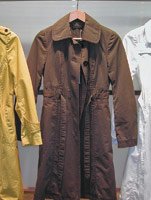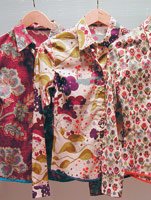High Turnout at L.A. Majors Market Helps Regain Fall Business
The introduction of the Los Angeles Majors Market at the California Market Center helped salvage the Fall season for many sales representatives who had to navigate a fractured schedule that included three separate markets in Los Angeles.
The new Majors Market (April 11–13), featuring collections that sell in department stores and large chains, ran concurrently with the Los Angeles Fashion Market (April 8–12), which includes collections for boutiques and specialty stores, as well as some department stores. These shows were scheduled three weeks after the newly launched Los Angeles Contemporary Market (March 17–23).
The calendar was divided this season when New York–based contemporary trade show Designers & Agents and several influential contemporary showrooms decided to launch the early Contemporary Market to woo international buyers and to give West Coast retailers greater access to New York–based collections.
Contemporary resources were largely pleased with the early market dates, although many acknowledged a decrease in traffic at the March market. Traffic at the April Fashion Market also suffered from the split season, many said. But the season was saved for many sales representatives at the CMC thanks to the high department store turnout at the Majors Market.
Buyers from Nordstrom Inc., J.C. Penney Co. Inc., Macy’s, Saks Inc., Dillard’s Inc., Gottschalks Inc., Belk Stores, Filene’s Basement, Lane Bryant and Sears, Roebuck & Co. worked the floors of the CMC. Specialty stores such as Horn and Kitson, both based on Los Angeles’ Robertson Boulevard; Anthropologie; and White House/Black Market also browsed the market.
Buyer attendance for the Majors Market was twice that of the Contemporary Market, according to Cecil Strickland, executive director of retail relations at the CMC. There was also a 45 percent increase in attendance from department store representatives working at the managerial level.
Strickland said the high department store turnout was a good sign for the Major Market’s future.
“If department stores don’t come to the show, they don’t believe in it,” Strickland said. “If they return in greater numbers, that’s a greater sign that there’s merit to making the trip.”
Creating a Fall show
The Fall Majors Market was a new endeavor for the CMC, which hosts a well-attended Spring Majors Market in October.
Department store buyers traditionally visit Los Angeles buying offices throughout the month of April, but buying offices Directives West, Bregman & Associates and Barbara Fields Buying Office have worked for the past few years to create the Fall Majors Market, said Sandy Potter, co-owner of Directives West. Their efforts bore fruit this year, when the CMC focused its marketing efforts on creating a cohesive three-day market tailored for the department store buyer.
“We were able to get everybody to come in at the same time,” Potter said. “First it was the directional stores. Then a lot of the other stores decided to come because this is where the market is.”
These stores were convinced by a few powerful factors, according to Potter and Sandy Richman, co-owner of Directives West. First, stores focused on juniors have devoted more time to Southern California because it is home to many juniors manufacturers and labels. The rise in celebrity magazines and their coverage of celebrities’ favorite Los Angeles stores also have helped pique buyers’ interest in the city as a fashion center, Potter said.
Richman said department stores have noted California’s dominance in the crucial field of premium jeans and in other clothing that is popular to wear year round. “California is no longer perceived as a Spring-only market,” she said.
Moshe Tsabag, chief executive of Los Angeles’ Hot Kiss Inc., said that despite its image as a sunshine state, California generates many new ideas in fashion throughout the year.
“Now it doesn’t matter whether it’s Spring, Summer or Fall,” he said. “We have a lot of creativity coming out of California, be it [in] the junior or contemporary market.”
Hot Kiss, which has $50 million in annual wholesale volume, received quite a few orders at the market for in-stock items such as its gypsy skirt and for products that will be shipped from May through September, Tsabag said. “Basically, it’s the same amount of traffic that we were experiencing in the October market,” he said.Hot Kiss saw Charlotte Russe Holding Inc., Nordstrom Inc. and Federated Department Stores Inc., among other retailers, and its appointments continued through April 15, Tsabag said.
Hot Kiss’ newly launched contemporary label, Jak & Rae, also experienced brisk business. With the first delivery set for April 30, Jak & Rae met with more major stores—including Federated’s Macy’s East, Nordstrom’s Chicago branch and Bloomingdale’s Inc.—in April than it did in March, according to Tsabag. He said he expects Jak & Rae’s annual wholesale volume to reach between $6 million and $8 million in the first year.
YMI Jeanswear International, whose juniors denim retails from $48 to $68, also said it received strong Fall orders from retailers, including representatives from Nordstrom’s Brass Plum department. “We saw everybody we wanted to see and then some,” said Marketing Director Dina de Fazio, who noted crosshatch styles and looks with rhinestone embellishments were among the popular Fall items.
Split decisions
Despite the confusion caused by the split Fall market weeks, many sales reps said they were pleased with the final results of the season.
For Michael Gae, the split markets encouraged many retailers to visit his Rep Et Trois showroom twice. “I got to spend more time with the customers. The extra time was reflected in the quality of the orders and the market,” he said.
Gae said his showroom earned 20 percent more during the Majors Market than it did during the Contemporary Market.
Liza Stewart, president of Liza Stewart Inc. on the CMC’s fifth floor, reported 50 percent to 75 percent growth in sales from some of her clients. But she credited the market’s overall success to the good economy and the popularity of California styles, not to the split scheduling, which she believes confused many buyers.
Some retailers took the split market in stride, said Susanne Zenker, owner of and buyer for Horn.
“I know my market dates,” Zenker said. “It’s up to each individual buyer how much they want to put into the market. It’s basically an extra opportunity. You can take it or leave it.”
Twice Brighte
The split market took a toll on exhibitor participation at the Brighte Companies show, held April 8–11 in the CMC’s fashion theater, according to Elyse Kroll, president of New York–based ENK International, which produces the event. Kroll said the number of exhibitors was down slightly from the March show, which provided exhibition space for 120 designers. But combined attendance for the March and April shows was 40 percent higher than the April 2004 Brighte show.
Retailers browsing the event included such iconic Sunset Plaza boutiques as On Sunset and H. Lorenzo, as well as Wendy Foster from Santa Barbara, Calif.
Los Angeles–based Sherry Nikka gave the April show a good review. Nikka sold a luxury line of sweats bearing her name. She said she landed more than $120,000 in orders at the show.
“It’s not about quantity,” Nikka said. “It’s about the quality of the buyer. They were totally focused, and they put pen to paper.”
Little crossover buying
Few buyers ventured beyond the walls of the CMC, according to Roman Valdez, a sales representative based in the Gerry Building.
“There was no foot traffic,” Valdez said. “It’s so hard to get people to cross the street.” Valdez is a sales representative for Blue Marlin Corp. of San Francisco.
Still, Los Angeles’ It Jeans met with buyers from Nordstrom and Macy’s in its showroom in the Gerry Building. In the second half of the split market, the company introduced new items that it plans to ship on Aug. 15, including wide-leg denim trousers ($32 wholesale). It Jeans Brand Manager Ricardo Carrera-Lowe said Macy’s East will move the line from its young contemporary section to the contemporary area for Fall 2005.
Good times, bad times
Ethan Eller, the manager of The New Mart, said the combined number of registered buyers for the March and April runs of the Fall 2005 market totaled 1,281, compared with 1,050 from last year’s show. He said some buyers came to both runs this year, although he did not track the number of duplicate visits. He said 829 buyers came in March and 452 in April and that approximately one-third of the showrooms closed during the April 9–10 weekend. Eller said the big question is: How much money did retailers spend? Because of the split market, he said, “everybody had to work twice as hard to make one dollar.”
Designers & Agents allowed a handful of companies that participated in its March 18–21 event to return in April and set up booths on the third floor of The New Mart for a mini market that some exhibitors dubbed “D&A lite.” Co-producer Ed Mandelbaum said D&A decided to host the April 8–11 run after it realized that some exhibitors had missed seeing some buyers because of the split market. “We let them use the third floor for appointments to get through the unusual season,” Mandelbaum said, adding that D&A charged one-sixth of the normal rate. For instance, a 10-foot space that normally cost $3,000 went for $500. Mandelbaum said D&A did not register buyers or advertise the informal event, which included 26 booths and 33 exhibitors and was about one-tenth the size of the March event.
New York’s Aubrey Co. was one of the showrooms that returned to Los Angeles for D&A. Sara Rachlin said she met with 10 accounts that saw four lines: Jungal, Marika Charles, New Scotland and Margherita 21. Although foot traffic was light, buyers wrote orders for sweaters, printed tees and wool coats, she said. Rachlinsaid the only major retailer that dropped by was Salt Lake City–based Sundance Catalog Co. “It was worth it for me,” she said.
The April session was “awkward,” according to Janice Burns, manager for Brothers & Sisters. The New Mart showroom—which represents Paige Premium Denim, Cris, Zooey, Future Paradise and City of Angels—did great business in March when D&A had its main show, Burns said. “Most of our customers go to that,” she said.
The story was similar for the showrooms at the Cooper Design Space. Mona Sangkala, leasing agent for the building, said the combined attendance from March and the most recent market was up 30 percent from a year ago. She said that compared with the March run, approximately 70 percent fewer stores came to the April event.
The Faith and More Showroom, located in the Cooper Design Space, saw less than half the people who came to the March market in April.
“I think the buyers are bought out,” said Cynthia Sakai, who runs Faith and More with Fares Saleh. “There were no new products for them to see.”
She said people do not really associate Los Angeles with Fall fashion. “It’s really hard to sell L.A. buyers a really cute jacket when the weather is hot out,” she said.
























